Super Collider Spending Raises Auditors’ Eyebrows : Science: Department of Energy questions $216 million in costs. Report adds fuel for House opponents who want to cut off funding.
- Share via
WASHINGTON — Federal auditors have questioned $216 million in costs associated with the superconducting super collider, concluding that they were part of a pattern of unreasonable expenses.
The findings were contained in a draft report prepared by the inspector general of the Energy Department, which oversees the $8-billion atom-smashing project. The report was made public Tuesday by the Project on Government Oversight, a nonprofit organization opposed to the super collider.
The release came two days before the House is scheduled to vote on whether to continue financing the project. The report is likely to bolster opponents, who believe they have enough votes to defeat the funding.
The Clinton Administration is lobbying to keep the project alive. President Clinton wrote Congress last week supporting continued funding, although he acknowledged that revised cost estimates will not be ready until early fall.
Leon E. Panetta, director of the White House Office of Management and Budget, said that the new report supports the Administration’s plan to stretch out costs for the project and bolster its monitoring of spending.
“I can’t answer for the waste that took place in the last Administration, but we do have to answer for any waste that takes place in this Administration,” Panetta said.
Super collider officials have denied that spending has been wasteful and have said they have kept a close eye on costs.
“We plain disagree with the criticism,” said Russell Wiley, director of external affairs for the super collider in Waxahachie, Tex. “Our entire system of cost accounting is the system required by the Department of Energy, and it has met with their approval.”
The report by the Energy Department’s inspector general echoes complaints by congressional investigators about cost problems associated with the project. However, the auditors took a tougher line than previous reports and examined a broader range of expenses.
“There was a pattern of unreasonable costs that went unchallenged,” the draft said. “We concluded that $216 million, or about 40% of the $508 million in subcontractor expenses we examined, were unreasonable because they were unnecessary, excessive or represented uncontrolled cost growth.”
Among the costs singled out were $56 million in overruns on two major subcontracts, which were not detailed, and an increase of $127 million on the major subcontract for technical and engineering work connected with construction of the super collider.
Wiley said that the $127 million was a planned increase. He said the criticism stemmed from an accounting difference with the auditors. Attempts to reach the auditors were unsuccessful.
The audit covered costs between January, 1989, and last October. It said that an additional $174 million in planned spending on the Texas project also did not meet guidelines for expenditures.
The findings are an important warning, according to the report, because only a small part of the anticipated money has been spent so far on the super collider.
“Unless . . . financial systems and controls are significantly improved, there is no assurance that federal funds appropriated to build the (collider) will be spent in support of the project’s mission,” the report said.
Along with challenging large overruns on contracts, the audit questioned many smaller costs, such as $56,000 for potted plants, $7,000 for hotel suites, $2,425 for liquor and $10,000 payments to UC Berkeley and Stanford University. The payments to the universities were not “prudent “ because they supported academic programs that the auditors said were not related directly to the super collider.
“Though many of the costs we considered unnecessary or extravagant were relatively small in amount, they can be more harmful to the project than more excessive costs that were incurred,” the audit said.
More to Read
Sign up for Essential California
The most important California stories and recommendations in your inbox every morning.
You may occasionally receive promotional content from the Los Angeles Times.










